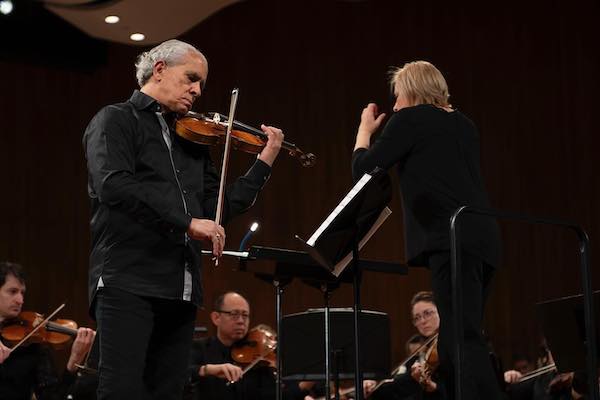Concert Review: Cambridge Symphony Orchestra Explores an Immigrant’s Journey
By Aaron Keebaugh
The Cambridge Symphony Orchestra’s recent performance supplied drama, vigor, and reflection.

The Cambridge Symphony Orchestra in action on March 24. Photo: Michael Sherman
The performance begins with somber tones. But before the sound grows to a churning ambiance, the solo violinist floats a melody that feels at once urgent and nostalgic. That single gesture lifts this concerto about your usual heroic musical journey. Sure, on the surface the piece suggests convectional uplift — the music is conveying the dramatic experiences of an immigrant who travels across the sea in hopes of building a better life. But if there’s an overarching theme in Miguel del Aguila’s “El viaje de una vida”(“The Journey of a Lifetime”) — his semi-autobiographical violin concerto from 2007 — it’s that an immigrant can never quite recapture the youthful bliss that was left behind.
In the hands of violinist Guillermo Figueroa and the Cambridge Symphony Orchestra under director Cynthia Woods, the concerto offered a moving spectacle of inner struggle and outward hope in a recent performance at MIT’s Kresge Auditorium.
Aguila relays this poignant musical narrative through styles that range from a kind of soft-boiled minimalism to sweeping lyricism that embraces the zeal of Spanish and Uruguayan traditional dances. What emerges is no pleasure cruise across the waves toward a promised land. Figueroa casts the protagonist as a dark — even mysterious musical presence — and with his amber violin tone he channeled the bittersweet emotions of a person who becomes lost in honeyed memories of times gone by.
The opening movement gives us the immigrant bound for America, filled with nimble orchestral gestures that fall somewhere between Philip Glass and Carlos Chávez. The passages conjure up images of a calm and prosperous voyage. Figueroa’s warm dialogue with solo clarinet generated the feeling that everything will turn out for the best.
But bringing this story-in-music to life involved tapping theatrical gestures. Figueroa used the stage effectively; he walked offstage before the second movement commenced. Playing from the wing, his exchange with the orchestra took on a weary wistfulness. Conductor Woods leaned into a generous rubato that emitted a dusky Old-World aura.
With the opening of the third movement, Figueroa gradually made his way back to center stage, unleashing a wild frenzy that echoed in the jota rhythms put across by the woodwinds. His new surroundings, the music suggested, sparked a myriad of excited thoughts in the protagonist. But the robust finale frequently returned to the pining lyricism that had opened the concerto. Only now the melodies carried a melancholic heaviness. Longing for home is a passion that travelers and immigrants share; Figueroa, Woods, and the CSO tapped into its haunting gravity.

Violinist Guillermo Figueroa performing with the Cambridge Symphony Orchestra. Photo: Michael Sherman
The rest of the program, featuring works by Erich Wolfgang Korngold, Bright Sheng, and Bela Bartók, channeled as much vigor as it did reflection.
The Korngold’s suite from King’s Row is familiar to film-score aficionados — its gallant opening theme was used by John Williams to graft the music that runs under the opening crawl of Star Wars. But King’s Row is also memorable for giving Ronald Reagan his most prominent Hollywood role (he played Drake McHugh, who wrestles with depression after losing his legs in an accident). The music revels in homegrown swagger. And Woods treated it as the pop classic it is, conjuring a warm resonance from the strings in the piece’s lyrical passages as well as a joie de vivre in its triumphant ones.
But, while King’s Row was rife with the kind of colorful contrasts and vivid textures that come naturally to the CSO, Bright Sheng’s Black Swan revealed the ensemble’s limitations. An arrangement of Brahms’s Intermezzo, Op. 118, No. 2, the piece requires the strings and winds to mesh in soft washes of sound. Woods and CSO didn’t waft through Sheng’s timbres — they tore through them. Woodwind answers to the strings were often harsh, at times even momentarily tentative.
Fortunately, the CSO was on firmer footing with Bartók’s suite from The Miraculous Mandarin. Composed in 1917, the ballet shocked audiences of its day because of its bawdy story of sexual aggression. The music offers enough furious energy to match its eroticism. Woods led with a keen feel for every wild mood swing. The opening string figures blazed, woodwinds shrieked and guffawed appropriately, and the thorny harmonies that make up the 19-minute suite sizzled. This was a Bartók geared towards all the senses — everything was fervent, vibrant, and simply a joy to experience.
Aaron Keebaugh has been a classical music critic in Boston since 2012. His work has been featured in the Musical Times, Corymbus, Boston Classical Review, Early Music America, and BBC Radio 3. A musicologist, he teaches at North Shore Community College in both Danvers and Lynn.
Tagged: Cambridge Symphony Orchestra, Cynthia Woods
